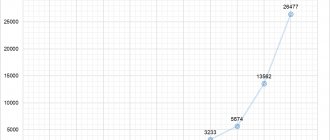Business lawyer > Accounting > EBITDA (ebitda, ebeda) in economics, what is it: application of indicators
Economic formulas and indicators serve as the basis for quick analysis and assessment of the state of a business for investors and other users of information. The mysterious EBITDA (ebitda, ebitda) in economics is a measure of assessing the success of various types of activities, comparing the economic achievements of competitors in the same industry. The indicator is widely used in developed economic countries around the world.
What is EBITDA
Deciphering this term will help you better understand this concept. EBITDA is formed from the initial letters of the English financial term Earnings before Interest, Taxes, Depreciation and Amortization. It can be literally translated as “earnings before interest on loans, taxes and depreciation.” Using this term, you can evaluate how much an enterprise is able to make a profit without taking into account the influence of loans, taxes and depreciation. This way, investors can assess the profitability of the core business with an unbiased view.
This indicator is especially popular among large companies. It allows international conglomerates, which traditionally have large capital expenditures, to present their financial statements in a more favorable light than standard financial statements.
Video - what is EBITDA in simple terms:
Investors pay special attention to EBITDA. The amount of real profit calculated using this indicator can significantly exceed a similar indicator calculated using advance costs. This is very important especially for those enterprises where the share of depreciation is high. In some cases, it reaches up to 30% of the cost of production. This applies, first of all, to steel production.
Despite the fact that this indicator can distort the real situation, investors still widely use it. This is because it helps to assess the extent to which the company is able to service its debts and reinvest funds for the further development of the business.
Areas of use
Around the world, economists calculate EBITDA and OIBDA for:
- comparison of achievements of objects of analysis engaged in similar types of business
- when assessing the creditworthiness of recipients of loans or loans
- stimulating staff work (as a basic guideline for determining the size of bonuses)
- banking sector
- presentation of the business object to potential investors
These indicators are often used to evaluate the level of return on investment for individual business areas.
The universal EBITDA indicator is convenient for analytical assessment of the current state of affairs in a company or firm. Its general availability and widespread use in world practice makes it easier to attract the necessary resources for business development. However, for long-term planning the indicator is not sufficiently acceptable, since it does not take into account the size of capital investments and the costs of sources of their financing.
Top
Write your question in the form below
History of the indicator in economics
EBITDA was originally used to measure a company's ability to service its obligations. To do this, the values of this indicator were compared for individual companies from the same industry, on the basis of which the amount of interest payments that would be used to pay off the debt was calculated. From this point of view, the company was seen as an asset that could be sold at an attractive price.
At the same time, we can note some nuances of calculating this indicator using this method. It was necessary to summarize the items that could be used to pay off the debt. At the same time, the cost of paying taxes could be taken as an additional basis for calculating debts, provided that all the company’s net profit was directed to the same purpose, and the business turned into an unprofitable one. As a result, the company ceased operations. But the creditors benefited. This indicator was readily used in the 80s of the last century.
How important is it to consider a company's EBITDA?
Who should use EBITDA? Firstly, organizations with a large amount of capital expenditures that write off fixed assets over a long period of time. With the help of EBITDA, their performance indicators become more attractive to potential investors. EBITDA masks a significant portion of their expenses.
However, many investors use this indicator to assess the investment attractiveness of a company because EBITDA allows them to assess its ability to develop, reinvest funds and repay debt obligations. EBITDA helps to benchmark similar companies and determine their position in the industry. The main purpose of such an assessment is to determine the value of the organization using information on the market value of similar companies.
Analogue organizations operating in the same market may have different growth rates, cash flows and potential risks. If these indicators are not adjusted, it will be difficult to make comparisons.
EBITDA is a good indicator for these purposes. Since interest on loans and taxes paid by the company are not taken into account when calculating profit, it can be used to compare companies with different tax regimes and levels of debt burden based on the total income received from all types of activities of the organization.
EBITDA is convenient to use for analyzing and forecasting the company's development in the short term. If you need to assess the investment attractiveness and potential of organizations for a longer period, then you should not rely on it, since EBITDA does not take into account the cost of depreciation of assets.
As we have already said, there is no clear opinion among financiers regarding this indicator. Thus, neither International Financial Reporting Standards (IFRS) nor US accounting rules (US GAAP) recognize EBITDA.
Experts believe that it should be used as an additional indicator when conducting a fundamental analysis of a company's securities or assessing the performance of competitors.
What does the EV/EBITDA ratio show?
Next, it is advisable to introduce the concept of EV and the EV/EBITDA ratio.
EV stands for Enterprise value, or company value. It can be defined as the sum of the capitalization of an enterprise and its debts. Investors need this valuation metric to compare different companies.
The EV/EBITDA ratio shows the company's value based on EBITDA. To calculate it, the following formula is used:
EV/EBITDA = (Capitalization + Long-term liabilities + Short-term liabilities) / Earnings excluding taxes, interest and depreciation.
The billing period is one year.
This indicator is used to compare companies with each other. With its help, investors can understand how much a company is undervalued or overvalued by the market.
However, it is important to take into account the industry in which the company being assessed operates. Developing industries are characterized by a higher rate. EV/EBITDA for more traditional industries will be lower. The factor of the country of origin of the company also influences the value of the indicator. Thus, the opposite situation is typical for developing economies, since traditional industries can develop at a faster pace than high-tech ones.
These factors should be taken into account when calculating the indicator.
How EBIT and EBITDA differ from operating profit
People who are far from finance and business often confuse operating profit and EBIT/EBITDA indicators. But they are different. EBIT/EBITDA includes income and expenses from all types of company activities (core, financial and investing), and operating profit includes only income and expenses from core activities.
Non-operating income and expenses (from financing and investing activities) are usually periodic and irregular in nature. These include income from one-time transactions, income from changes in exchange rates, expenses that cannot be attributed to the main activities of the organization. And income from the sale of fixed assets, reserves for doubtful debts, and repaid receivables are included in operating profit, since they are related to the main activities of the company.
Operating profit is part of another synthetic indicator - OIBDA (operating income before depreciation and amortization - operating profit before depreciation of fixed assets and intangible assets). This indicator differs from EBITDA in its composition: it includes only operating profit, excluding non-operating income and expenses.
Features and formula for calculating EBITDA
Since EBITDA is mainly used by companies that have already entered the global market, it is calculated according to international standards. This increases the competitiveness of domestic products, since in this case investors will have more complete information.
This indicator is not used in accounting. However, to calculate it you will need data from the financial statements. Since they are widely available, it compares favorably with other profitability indicators in its ease of calculation.
To calculate EBITDA you must have the following information:
- net profit;
- income tax expenses and the amount of its reimbursement;
- extraordinary expenses and income;
- interest paid and received;
- depreciation deductions;
- revaluation of assets.
All of these indicators, except the last one, form operating profit (EBIT). It is necessary to calculate EBITDA. To calculate it, you need to subtract the costs of day-to-day operations from the company's gross profit. The following formula will help you calculate:
EBIT = Net Income + Tax Expense - Tax Recovered + Extraordinary Expenses - Extraordinary Earnings + Interest Paid - Interest Earned
EBIT can only be positive. Now you can calculate EBITDA
EBITDA = EBIT + depreciation - revaluation of assets
It should be noted that we calculated the indicator without taking into account payments: taxes, debts and depreciation.
However, you can use a simplified formula for calculating EBITDA:
EBITDA = revenue – operating expenses
Also, the formula for calculating the indicator can be written as:
EBITDA = Revenues – Expenses + Taxes + Interest on debt + Depreciation and amortization
If you look at the balance sheet data in Form 2, then “Revenue” is taken from line 2110 “Proceeds from sales”, and “Expenses”, respectively, from line 2120 “Full cost”. Lines 2410+2421 +/- 2450 form “Taxes”, and line 2330 - “Interest on debts”. As for depreciation charges, their value should be taken from the Appendices or Explanations.
To make the formulas clearer, let's give an example. To do this, we will use a simplified formula. Let's say you need to calculate EBITDA for . To do this we use the formula:
EBITDA = Profit before tax (2300) + Interest paid (2330) - Interest received (2320) + Depreciation
The Explanation to the annual reports states that the amount of depreciation is RUB 60,000,000.
Data from the financial results report of Romashka LLC for 2017.
| Indicator name | Line code | Data for the year (RUB) |
| Profit (loss) from sales | 2200 | 332 673 919 |
| Income from participation in other organizations | 2310 | 139 211 136 |
| Interest receivable | 2320 | 67 912 187 |
| Percentage to be paid | 2330 | 119 740 422 |
| Other income | 2340 | 4 495 250 616 |
| other expenses | 2350 | 4 283 878 698 |
| Profit (loss) before tax | 2300 | 631 428 738 |
Then, EBITDA = 631,428,738 +119,740,422 - 67,912,187 + 60,000,000 = 743,256,973 (rub.)
According to the calculation results, we can conclude that Romashka LLC is able to service its obligations, which form an annual debt payment of no more than 743.3 million rubles.
Types of EBITDA indicators
In practice, absolute indicators do not make it possible to fully assess the performance of a business structure, its ability to repay debts, and objectively compare them with similar information on competitors. For this purpose, relative values are used: profitability and creditworthiness.
The EBITDA profitability ratio is calculated as the ratio of absolute size to revenue.
Analysis of financial performance indicators
Based on the results of Example 1:
Kr = 342 / 1500 = 0.228
Based on the results of Example 2:
Kr = 12.6 / 50 = 0.252, that is, the second company has better financial and economic performance indicators.
For analysts and potential investors, it is important to determine the ability of a business entity to repay debts on time. One of the characteristic indicators of loan repayment is the ratio of the total amount of debt obligations to the estimated EBITDA value.
The debt ratio is calculated using the formula:
S debt / EBITDA, where S debt is the total amount of debt obligations as of the target date.
Example 3. The company considered in the previous example had a total debt amount of 28 million rubles as of January 1, 2021.
Debt ratio 28 / 12.6 = 2.222.
According to financial analysts, a debt EBITDA ratio of within 3 units indicates the financial reliability of the company. If the indicator exceeds 4 units, there are serious risks regarding the timely repayment of obligations.
Company's EBITDA margin
Let's take a closer look at the EBITDA margin, which was discussed earlier. This ratio is the ratio of EBITDA to sales revenue, which is reflected in the calculation formula:
EBITDA margin = EBITDA / Revenue
What is the purpose of this indicator? It characterizes the company’s performance without taking into account the influence of the taxation system and the size of debt obligations. Therefore, using EBITDA margin, you can benchmark and compare the performance of companies from the same industry with different capital structures and operating in different countries.
According to experts, with an EBITDA margin above 12%, the company operates quite efficiently. If the value of the coefficient is less or even close to zero, then it means that the organization’s management needs to take urgent measures to prevent bankruptcy and overcome the crisis.
Bringing EBITDA to a single denominator
Financiers actively use EBIT and EBITDA indicators to analyze the financial condition of companies and assess the value of a business. In the reporting of many companies, prepared in accordance with the requirements of international financial reporting standards, these so-called non-GAAP indicators can be found.
However, there is no uniform calculation methodology, and different companies calculate these indicators differently. As a result, they are difficult to use to compare the performance of organizations operating in the same industry. It turns out that the main advantage of the EBITDA indicator is offset by the use of different calculation methods. Also, due to the fact that in financial practice there is no uniform standard for the formation and presentation of non-GAAP indicators in official reporting, companies have more opportunities to embellish them to increase investment attractiveness in the eyes of investors.
In the early 2000s. Many companies actively used EBIT and EBITDA in their reporting to attract the attention of potential investors. The state regulator could not help but notice this. Initially, US GAAP reporting was used to calculate EBIT and EBITDA, and the calculation rules were regulated by the US Securities and Exchange Commission (US SEC). In accordance with the requirements of the US SEC, EBIT and EBITDA are calculated using an original formula; data for calculation is taken from reporting generated in accordance with GAAP standards. The final figure does not include taxes, interest or depreciation. It is prohibited to exclude other types of expenses from the calculation of indicators.
If a company calculates profit in any other way, then it cannot call it EBIT and EBITDA. Therefore, in this case, the prefix “adjusted” is added to the name of the indicator. For example: “adjusted EBIT”, “adjusted EBITDA”, “adjusted OIBDA”, etc.
Adjusted EBITDA is typically further stripped of the following items:
- expenses and income not related to the main activity of the organization (previously they were called emergency and non-operating). This is possible provided that the reporting contains relevant items or they can be isolated from the total indicators in some way;
- exchange rate differences associated with the dynamics of exchange rates;
- loss from the sale or disposal of current and non-current assets;
- losses from a decrease in the value of various groups of assets, including the reputation of the enterprise;
- stock-based compensation;
- financial results from ownership and management of shares in associated and joint ventures and operations;
- creating reserves for various purposes (for vacations, for major repairs, for doubtful debts, etc.).
Example 1. As an example of calculating EBITDA, let’s consider the group’s financial statements for 2014, prepared in accordance with IFRS requirements.
Note 39 to the annual financial statements, “Segment Information,” on page 55 explains the concept of “Adjusted Segment EBITDA.” The calculation of the adapted indicator does not include tax liabilities, interest expenses, depreciation, exchange rate differences and other costs not related to the company's core activities. In addition to the obtained value, Gazprom's share in the profits of associated and joint ventures is added.
See page 57 for an explanation of how Adjusted EBITDA is calculated within the group. Thus, in the calculation of the indicator, in addition to traditional expense items, “Other expenses” and “Loss from exchange rate differences” are included, which are classified as non-operating. And at the end, the final indicator is clarified taking into account the results of the work of associated and joint ventures:
If you calculate the EBITDA indicator in the group in the original way, you will get the following value:
Thus, it can be seen that the deviation of the EBITDA value calculated in the traditional way from the adapted version is about 30%. This gap in the two indicators is due to the fact that adjusted EBITDA additionally takes into account exchange rate differences and the organization’s shares in associated companies.
Example 2. Let's look at the features of calculating EBITDA using the example of the X5 Retail Group company, which prepares reports in accordance with the requirements of international financial reporting standards (IFRS). To ensure comparability, data are also presented for 2014.
The company's official annual reporting uses the adjusted EBITDA indicator, which, in addition to depreciation, taxes and interest on loans and borrowings, also does not include impairment losses (impairment), exchange rate differences (net foreign exchange result) and share of loss of associates.
If you calculate EBITDA in the traditional way, you get the following:
Thus, the adjusted EBITDA according to the reporting data for 2014 is 6% less than calculated in the traditional way. The main reason for this deviation is the accounting for impairment of non-current assets in the adjusted version of EBITDA. In 2013, both indicators were practically at the same level, since the impact of asset impairment was insignificant.
We recommend
“Part-time work: registration rules, difficult situations” Read more










